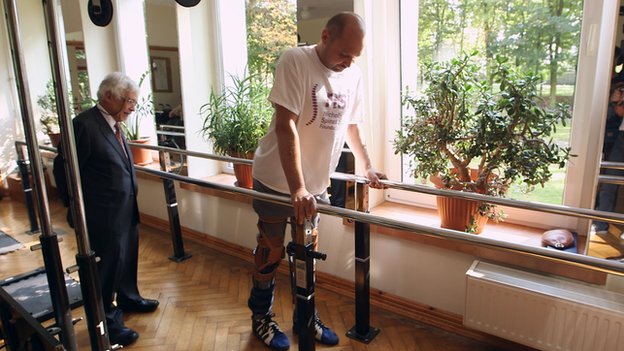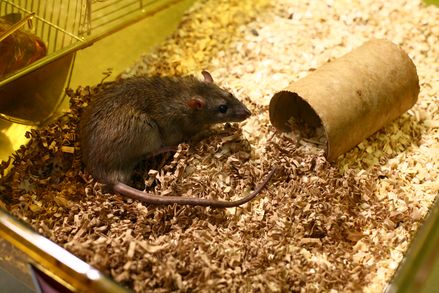Man Walk Again After Transplant
Today, nigh 30 years after Prof. Geoffrey Raisman start identified their potential to repair nerve impairment in mice, the BBC reports that olfactory ensheathing jail cell transplantation has been successfully used to enable Darek Fidyka, who was paralyzed from the chest down in a pocketknife set on in 2010, to walk again.
The paper reporting the transplant, which was carried out by surgeons in Poland and led by Geoffrey Raisman of the UCL Establish of Neurology, is published today in the periodical Jail cell Transplantation (5). The technique involves taking specialized cells known as olfactory ensheathing cells (OECs) from the patient's own patient'due south olfactory bulbs, and then grafting these cells at the site of injury, where they promote nerve cell growth to bridge the gap and restore function. An added reward in using the patient's ain cells is that it avoids the problem of rejection by their immune system.
Speaking earlier today Geoffrey Raisman described the results as "more impressive than human walking on the moon". He's not to far wrong, this achievement shows what is possible for regenerative medicine, and is the consequence of decades of bones and translational research. Indeed, whereas simply 12 people take walked on the moon, this new technique has the potential to assistance many thousands of people to walk once more here on earth.
2014 has been an extraordinary twelvemonth of progress restoring function after spinal injury, in May we saw how epidural stimulation allowed 4 paralyzed men in the US to move their legs again, while scientists at Newcastle University in the UK used airtight loop electrostimulation to restore voluntary motility in temporarily paralyzed monkey arms. These techniques, and now OEC transplantation, evidence that many cases of paralysis are potentially reversible. Not every technique will exist appropriate for every patient, and it will have much additional research before they are widely available, only together they represent a huge advance.

In each example it is an accelerate that rests on many decades of careful enquiry in both animals and in human subjects, in detail basic research that uncovered the role of specialized cells and provided scientists with the knowledge about organization and function of the brain and spinal cord that enabled these pioneering therapies to be developed.
In a mail in 2012 I discussed how Geoffery Raisman's enquiry led to the successful testing of olfactory ensheathing cells in injured dogs, and I'm reposting that article here:
Paralysed dogs walk once more thanks to nasal prison cell transplants…and Professor Raisman's rats. (published xix November 2012)
This morning the BBC News carried a report on a medical quantum – and it is not a term I use lightly – that has enormous implications for people who have been paralyzed post-obit spinal cord injuries. A team at the University of Cambridge led by Professor Robin Franklin Department of Veterinarian Medicine, forth with colleagues at the MRC Eye for Regenerative Medicine in Edinburgh succeeded in restoring the power to walk with their hind legs to dogs which had been paralyzed by spinal injury. To do this they removed a special type of cell chosen the olfactory ensheathing prison cell (OEC) from the nasal passageways of the dogs, grown them in culture until a sufficient number had been produced, and then transplanted them at the site of injury. Many of the dogs which received the transplant were subsequently able to walk with their hind legs if supported by a harness, and some even able to walk without being supported by a harness, whereas dogs which received a control injection did not recover the ability to motility their hind legs.
This is a major medical advance, and the showtime time that cell transplantation has been demonstrated to reverse paralysis in a existent-life situation where the injury involves a combination of impairment to the nerve fibre and to surrounding tissues, and in that location is a significant filibuster betwixt injury and treatment, and while the therapy did not completely restore function information technology marks a very pregnant footstep towards a therapy that can be evaluated in a human clinical trial. Information technology also of course is a very promising therapy for dogs that accept suffered spinal injuries, for example after being hitting by a car, and as such is an fantabulous example of the One Wellness concept which seeks a closer integration of human and veterinary medicine.
As with many breakthroughs this ane did not happen overnight, indeed information technology is the event of decades of enquiry. The story really begins in 1985 when Professor Geoffrey Raisman at University College London (for a good overview of his work see the UCL spinal Repair Grouping homepage) was studying the unique ability of nerve fibres in the olfactory organization to grow and make the connections with fundamental nervous organization – an ability that other adult nerve cells lack and which is probably retained in the olfactory system due to the importance of preserving the ability to smell despite exposure of nerve cells in the nasal passages to toxins in the environment (a good sense of olfactory property being crucial to survival for many mammalian species). He institute that in a function of the encephalon termed the olfactory bulb of mice and rats a specific type of glial cell, cells that act to support and regulate the activeness of the nervus cells along which nerve impulses travel , were responsible for creating the pathway along which the olfactory nerve fibres could regenerate (1).

Studies in rats were key to unlocking the potential of olfactory ensheathing cells in repairing spinal injuries. Image courtesy of Agreement Animal Research
This discovery suggested that if these specialized olfactory ensheathing cells (OECs) were transplanted at the site of spinal cord injury they might promote the growth of a bridge of nervus cells that would reconnect the severed pathway and restore function. In a series of experiments in rats Professor Raisman and colleagues demonstrated that OEC transplantation could repair a variety of dissimilar types of spinal cord injury, in order to restore function, for instance to better the ability to breath and climb following spinal cord injury (2) and to restore the power of rat paws to grasp in order to climb post-obit lesion of the spinal nerve that runs from the spinal cord down through the arm (three). Other scientists provided boosted key information, for example scientists at the Academy of New S Wales in Australia demonstrated that OECs could be isolated from the nasal mucosa too as from the olfactory bulb (four), and that these tin likewise repair spinal cord injuries, an important step since obtaining OECs from the nasal mucosa is far more straightforward and safer than harvesting them from the brain. These discoveries, and the refinement of OEC transplant techniques over the by 2 decades by scientists such as Prof. Raisman, paved the way for the "real life" veterinary study reported today. A human clinical trial of this technique cannot be far off, though it is worth noting Prof. Raisman's words of caution to the BBC apropos what has been achieved and what is still to be done:
"This is not a cure for spinal cord injury in humans – that could still exist a long fashion off. But this is the virtually encouraging advance for some years and is a meaning step on the route towards it…This procedure has enabled an injured dog to pace with its hind legs, simply the much harder range of higher functions lost in spinal string injury – hand part, bladder office, temperature regulation, for example – are yet more complicated and still a long way away."
In this respect it is worth noting the other approaches to repairing spinal cord injury, for example using other glial cell known as astrocytes and the use of electrical stimulation accept produced promising outcomes in animal studies and early human being clinical trials. Indeed, a clinical study of electrostimulation that nosotros discussed last year reported "improved autonomic role in float, sexual and thermoregulatory action that has been of substantial do good to the patient". In the time to come these unlike approaches may be combined to maximize the benefit to the patient, but it is still far besides early on to say which techniques volition best complement each other. One affair we can be sure of is that turning these very promising technologies into effective treatments – perhaps even cures – for paralysis will require further research, both in the lab and in the clinic.
Paul Browne
1) Raisman G. "Specialized neuroglial arrangement may explain the capacity of vomeronasal axons to reinnervate fundamental neurons." Neuroscience. 1985 January;14(1):237-54. PubMed: 3974880
2) Li Y, Decherchi P, Raisman Grand. Transplantation of olfactory ensheathing cells into spinal string lesions restores breathing and climbing." J Neurosci. 2003 February 1;23(iii):727-31. 12574399
3) Ibrahim AG, Kirkwood PA, Raisman K, Li Y. "Restoration of mitt part in a rat model of repair of brachial plexus injury." Brain. 2009 May;132(Pt v):1268-76. Epub 2009 Mar thirteen. PMID: 19286693
4) Lu J, Féron F, Mackay-Sim A, Waite PM. "Olfactory ensheathing cells promote locomotor recovery afterward delayed transplantation into transected spinal cord." Brain. 2002 Jan;125(Pt i):14-21. PMID: 11834589
five) Tabakow P et al. "Functional regeneration of supraspinal connections in a patient with transected spinal cord following transplantation of bulbar olfactory ensheathing cells with peripheral nerve bridging" Cell Transplantation, published online xx November 2022 http://world wide web.ingentaconnect.com/content/cog/ct/pre-prints/content-CT-1239_Tabakow_et_al
Source: https://speakingofresearch.com/2014/10/21/paralysed-man-walks-cell-transplant/
0 Response to "Man Walk Again After Transplant"
Post a Comment